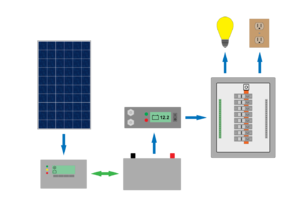Low voltage disconnect
A load voltage disconnect (LVD) is a key component of a PV system that disconnects loads from the battery bank if the battery bank drops below a certain voltage. This is important as it protects the batteries from over-discharge which can greatly reduce their cycle life. A low voltage disconnect is often integrated into charge controllers and inverters, but also may be a stand-alone component when larger DC loads, like water pumps or refrigerators, that need to be connected directly to the battery bank are used. If the LVD is integrated into a charge controller or inverter, it is important to check whether it is possible to program a higher or lower voltage that may better suit the needs of the system. The proper setting for the LVD will depend upon the type of energy storage system that is used.
Lead acid batteries
The factory LVD voltage on many components designed for use with lead acid batteries is set to a very low value of around 10-20% state of charge. Most lead acid battery manufacturers do not recommend that a deep cycle battery regularly be discharged beyond 50% state of charge, therefore it is worth considering raising this value. It is important to note that voltage of an energy storage system can drop rapidly if it is put under significant load and could cause a LVD with too high of a voltage value to disconnect the loads when it is not desirable. It is necessary to determine a voltage that is a proper balance for the particular system.
